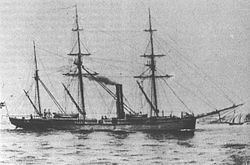Name Meteor Beam 6.96 m (22.8 ft) Launched 17 May 1865 | Draft 2.67 m (8 ft 9 in) Length 43 m | |
 | ||
Propulsion | ||
SMS Meteor was a Camäleon-class gunboat of the Prussian Navy (later the Imperial German Navy) launched in 1865. She fought in the Battle of Havana during the Franco-Prussian War in 1870.
Contents
Design
Meteor was 43.28 meters (142.0 ft) long, with a beam of 6.96 m (22.8 ft) and a draft of 2.67 m (8 ft 9 in). She displaced 422 metric tons (415 long tons; 465 short tons) at full load. The ship's crew consisted of 4 officers and 67 enlisted men. She was powered by a pair of marine steam engines that each drove one 3-bladed screw propeller and two coal-fired trunk boilers, which gave her a top speed of 9.3 knots (17.2 km/h; 10.7 mph) at 320 indicated horsepower (240 kW). As built, she was equipped with a three-masted schooner rig. The ship was armed with a battery of one rifled 15 cm (5.9 in) 24-pounder gun and two rifled 12 cm (4.7 in) 12-pounder guns.
Service history
Meteor was laid down at the Königliche Werft Danzig (Royal Dockyard Danzig) on 27 June 1861. Construction work on the ship was delayed significantly due to a lack of funding, the result of budgetary conflicts between Minister President Otto von Bismarck and the Prussian House of Representatives. The ship was launched on 17 May 1865, though fitting-out work was delayed the following year when the ship was allocated to an expedition to the North Pole. The ship finally was commissioned into service with the Prussian Navy on 6 September 1869. The Admiralstab (Admiralty Staff) ordered the gunboat to the Caribbean, along with the corvette Arcona. The sailors were concerned with Meteor's seaworthiness for an Atlantic crossing, and so planned to transfer the 15 cm gun to Arcona for the voyage. Arcona was instead reassigned to represent Germany at the opening of the Suez Canal, however, and so Meteor was forced to make the journal on her own. She departed Kiel on 4 October, under the command of then-Kapitänleutnant (Captain Lieutenant) Eduard von Knorr. While en route, she had to put into Falmouth from 12 October to 6 November to repair damage sustained during a storm in the North Sea.
Meteor arrived in Bridgetown, Barbados on 19 December, where she met the training ship Niobe. The gunboat was unable to stay in Barbados, as unrest in Venezuela threatened German nationals in the country, and so she was ordered there to protect them. She remained in the area until mid-March, and at the beginning of the month, she anchored off La Guaira with Niobe in an attempt to enforce German financial claims in the city. During the period she operated off Venezuela, Meteor left once for periodic repairs at Willemstad, Curacao. On 16 March, she left Venezuelan waters, bound for Port-au-Prince, Haiti, where she was to meet Arcona. While on the way, Meteor struck a coral reef off Gonâve Island, though she was able to get off on her own power. After arriving in Port-au-Prince, Knorr learned that Arcona had gone to La Guaira, and he was to take his vessel there as well.
Battle of Havana
On 7 November, Meteor arrived in Havana, Cuba, where the French aviso Bouvet was docked. The French ship was more heavily armed than the Prussian vessel, with one 16 cm (6.3 in) gun and four 12 cm (4.7 in) guns compared to a single 15 cm (5.9 in) gun and two 12 cm guns aboard Meteor. The French captain issued a challenge to von Knorr, who accepted. Bouvet departed the harbor on 8 November, followed by Meteor the following day; international law mandated that belligerent ships wait twenty-four hours after an enemy vessel left port. The Battle of Havana—the only engagement between Prussian and French warships during the war—lasted for two hours, with Meteor opening fire first with her 15 cm gun.
Meteor fired eight salvos at about 2,000 meters (6,600 ft), all without effect, before Bouvet returned fire, once the range had fallen to 800 meters (2,600 ft). Neither ship scored hits as they circled each other. The engagement ended after Bouvet rammed Meteor in an attempt to either sink her or permit a boarding party to capture her. The collision knocked Meteor's main mast and mizzen-mast over, and the ship's rigging got caught in the propeller, disabling it. While the two ships were close, their crews fired on each other with small arms. Bouvet attempted to ram a second time, but Meteor's gunners scored a hit on the French ship's boiler and disabled her engine. By this time, Meteor's crew had freed the propeller, and Knorr attempted to capture Bouvet, but the French sailors were able to get their ship under sail and escape to neutral Cuban waters. The Spanish corvette Hernan Cortez, which had been observing the battle, intervened and fired a warning shot to prevent Meteor from continuing the battle. After she escaped, Bouvet sailed to Havana.
Casualty figures vary, ranging from two dead and one injury aboard Meteor and three wounded aboard Bouvet to only two Prussian sailors killed with ten killed and wounded on Bouvet.
Later career
Meteor's career did not last long after the end of the Franco-Prussian War in 1871. She was stricken from the naval register on 27 November 1877 and used as a hulk for coal storage at Kiel. The ship was eventually expended as a target.
